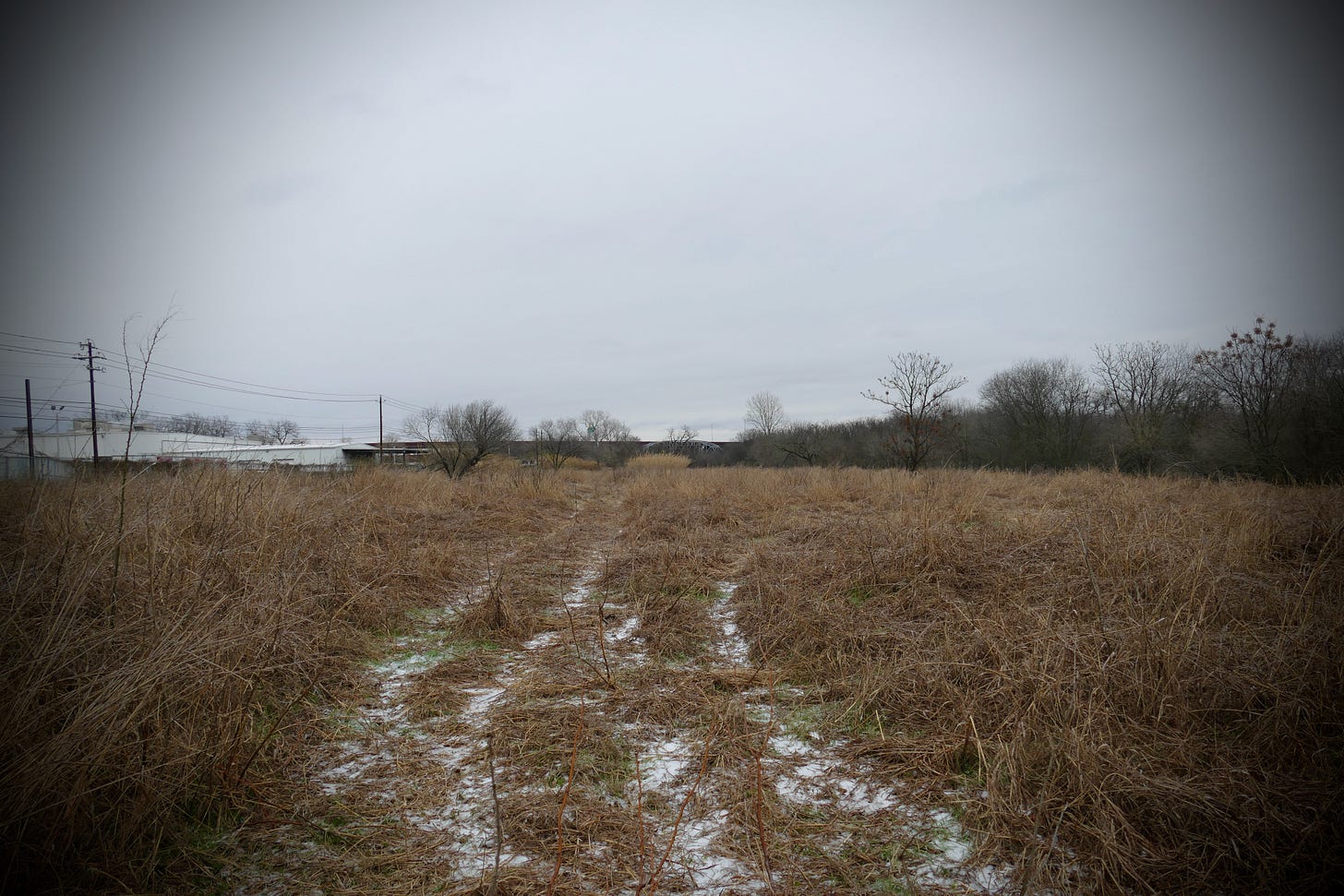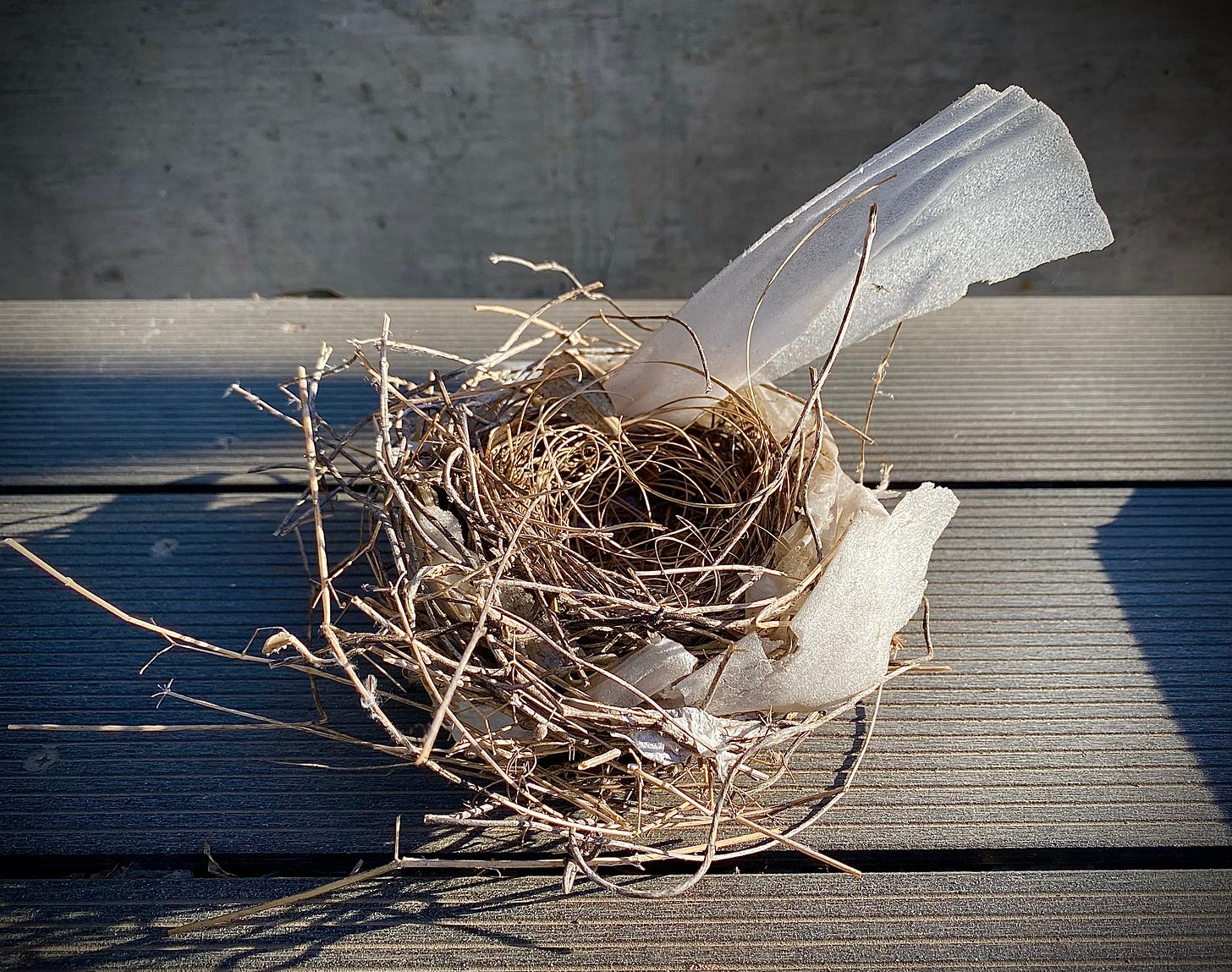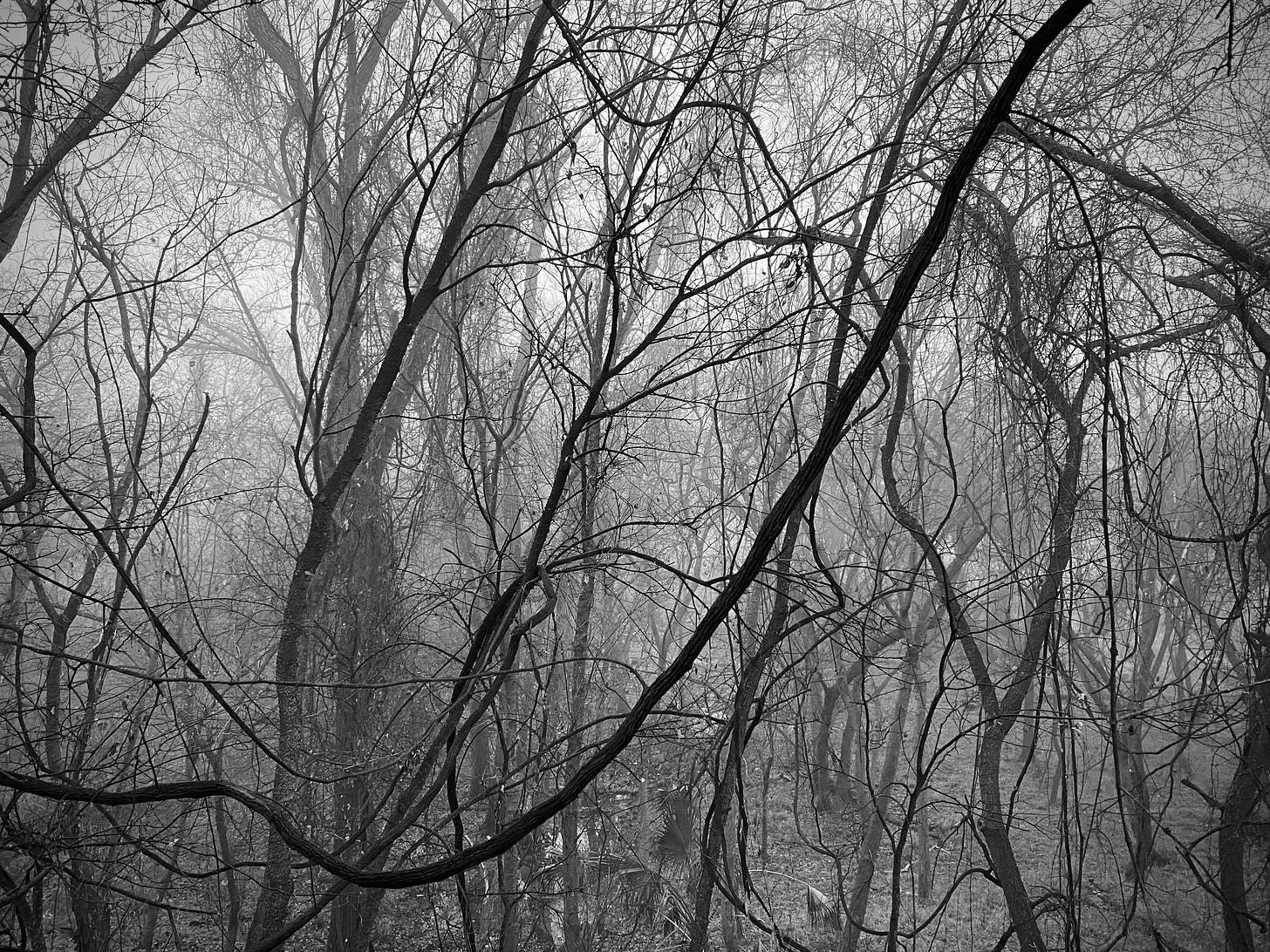Bluebonnets on ice
Before the winter storm blew in Wednesday afternoon, the vultures were out in force. They didn’t need the push notifications or the robocalls the rest of us got from the politically anxious state authorities, warning that a freeze was coming. I saw this one mid-morning sitting atop the sign where the road divides at the base of the off-ramp, waiting for the first wreck to come hurtling down the black ice. Vultures know where the roadkill is, and sometimes I wonder if they can tell it’s just a matter of time before our social systems fail badly enough that they’ll be able to get to the ejected occupants of the vehicles faster than the first responders.
A couple of blocks away stand a bunch of Quonset huts that have been there since the nearby airport was an Air Force base. Until a few years ago they were still active as open-air machine sheds and workshops, but now they are being repurposed as playgrounds of the idle weekenders who drive over here from the less feral parts of town. Beer halls for tech bros, one of which is now owned and operated by an actual Bavarian prince whose real name is longer than your private Bitcoin key but goes by “Koko,” which sounds like the name of a scary clown. Behind Koko’s is an old construction barn in which some wizards use autonomous drones to optimize the velocity of retail shelf inventory. It was across from there, behind the chainsaw sculpture garden of shamans and saints carved by one of the older residents of the neighborhood, that earlier Wednesday morning I saw two vultures looking guilty behind a shipping container painted with a beautiful mural by my friend Federico.
That little strip of scrubby dirt along the driveway is one of those zones where you often encounter the animals that have crawled as far as they could after being hit by a vehicle on the high-speed roadway nearby. Not too long ago I found a freshly bisected cat, and wondered what urban scavenger had managed that slice. Wednesday’s prize was a day-old opossum in the shadows behind the container, recognizable mainly by the big hairless tail the carrion crows were saving for last.
The morning before, the first day of February, the edgeland cur and I walked down into the woods behind the door factory, which were thick with fog that came in after the rains. We navigated our way through the maze of fallen trees along the bluff, down into the lagoon where the drainage ditch behind the gypsum yard turns into a creek. The mud was densely tracked with the prehensile prints of raccoons. On the other side we stepped into a grove strewn with floodplain flotsam, and then stumbled upon the carnage of the night before.
The coyotes had taken the young stag in the rain, and the darkness of the new moon. You could see the signs of the urban canids fighting over how to divide up their kill—a pile of skin and fur over there, severed and half-skinned legs on either side, and the limbless main skeleton at the center of the scene, antlered skull still regal even though it had been twisted all the way around on its vertebral stalk. Maybe it was the rain that had made the carcass so easy for the coyotes to skin, like ripping off wet clothes.
The scholars say February gets its name after the Roman festival Lupercalia, an annual rite of municipal purification apparently derived from some more savage tradition of the Sabines. The ritual took place every year at the site of Romulus and Remus’ suckling by the she-wolf, with a sacrifice of goats and young dogs. The goats were skinned, and the devotees would adorn themselves with fragments of the skin, cutting other pieces into thongs—the februum—with which they would then run through the streets flagellating whoever they saw in a symbolic cleansing of the land and summoning of the fertility of its people. Ovid thought the name februare was tied to an Etruscan word for purging; others theorize it ties to the Latin root of fever, for the sweating out of sickness and impurity. The Greek precedent was an Arcadian festival under the patronage of wolf-Zeus, in which teen boys would participate in a secret ritual that might result in them turning into werewolves, the social purpose evidently to ward off the evils of cannibalism in hard times.
I was not thinking about any of that as the warnings bombarded our own municipality that another winter storm event was coming, just shy of a year after the weeklong hard freeze power outage that killed a few hundred people. I was remembering that week and its minor traumas and major stresses, and wondering whether we were ready. You could tell the whole town felt that way, a collective PTSD welling up as the rain started again right before the temperatures dropped. On the other side of it now, I wonder if February has become the recurring date when the Texans undergo their annual purification through the cold they are never really prepared to endure.
The rain started to freeze not long after the sun set, and an intensely cold wind started to blow. In the morning, the city was blanketed in a thick coat of sleet and ice, which would not have been that big a deal in more northern climes, but in a place where the authorities do not even have basic equipment and materials to clear the roads of winter precipitation, it shut everything down for two days.
On the highway that runs through the dry Sierra east of Tijuana, between Tecate and Mexicali there’s a mountain pass called la Rumorosa, for the way the wind blowing through the surreal rock formations sounds like whispering ghosts. I thought of that place Thursday morning, when I walked out before dawn to hear eerie sounds from the frozen woods. A kind of crazy song, stranger and more shrill than the calls of the coyotes and foxes when they get rowdy, but too vocal to be the sound of the branches bending against the ice. Then I heard the sirens hurtling down the nearby traffic arteries, trying to beat the vultures to the first wrecks.
The temperature had dropped more than forty degrees in a day, from the 60s to the 20s, and most schools and workplaces had already announced their closure at the very possibility. The city becalmed, with the power and heat thankfully still on other than a few scattered and brief outages. All the green plants that had come up out of the ground in the warmer weeks that preceded were now coated in ice.
No cars on the roads nor people about. When I went for a run at mid-day, the north wind threw the sleet in my face like tiny shards of glass as I crossed the iced-over bridge. Down below, the guys with the new camp under the overpass had built a fire that flickered in the cold shadows.
It got even colder Thursday night, around 20 with a sharp wind that made it feel closer to 5. Friday morning I heard that eerie Ligeti chorale from down in the woods again, even longer. Icicles dangled from the steel frames of our green roof, a very rare sight down here.
Lupe and I headed down to the river at sunup. The back lock was frozen shut, so we trespassed our way through using another route. The Colorado was lifeless below the dam, a slow cold viscous flow muddied with rainwater, no birds to be seen other than a few sparrows we inadvertently flushed from their cover in the brush along the banks. The heron rookery was empty, and I wondered where the great blues go when it’s too cold in their tall sycamore perch. The only signs of morning activity were the fresh deer pellets the dog found, their tracks in the frozen mud visible only as fine scratches.
We walked back into the woods, seeking cover, and worked our way up to the field behind the dairy plant. Just a skeleton crew keeping the machines running, and when we snuck through the fence into the industrial cul de sac we came upon the big tanker trucks with ice layered over their grungy chrome. I remembered the early days of the pandemic, when the whole world seemed to shut down, and you could briefly imagine how different it could be.
Friday afternoon the sun came out, and everything started to melt off quickly. The wind had dislodged one of the cardinals’ nests from the cross vine that hangs from the green roof over our bedroom window, and my daughter and I admired its Anthropocene wonder—a shelter for baby birds made from fine reels of dead foliage insulated with layers of industrial materials salvaged from the nearby factory yards: fragments of open-cell polyethylene foam roll, plastic wrap, and computer paper, some of it chewed and spit out like avian papier mâché. It made me wonder if they are better prepared for whatever permanently weirder weather is coming than we are.
Further reading
For a deeper read on the festival of February, this entry at LacusCurtius is pretty great, and links to a 1921 dissertation on the holiday by Alberta Mildred Franklin:
LUPERCA′LIA, one of the most ancient Roman festivals, which was celebrated every year in honour of Lupercus, the god of fertility. All the ceremonies with which it was held, and all we know of its history, shows that it was originally a shepherd-festival. Hence its introduction at Rome was connected with the names of Romulus and Remus, the kings of shepherds. Greek writers and their followers among the Romans represent it as a festival of Pan, and ascribe its introduction to the Arcadian Evander. This misrepresentation arose partly from the desire of these writers to identify the Roman divinities with those of Greece, and partly from its rude and almost savage ceremonies, which certainly are a proof that the festival must have originated in the remotest antiquity. The festival was held every year, on the 15th of February, in the Lupercal, where Romulus and Remus were said to have been nurtured by the she-wolf; the place contained an altar and a grove sacred to the god Lupercus. Here the Luperci assembled on the day of the Lupercalia, and sacrificed to the god goats and young dogs, which animals are remarkable for their strong sexual instinct, and thus were appropriate sacrifices to the god of fertility. Two youths of noble birth were then led to the Luperci, and one of the latter touched their foreheads with a sword dipped in the blood of the victims; other Luperci immediately after wiped off the bloody spots with wool dipped in milk. Hereupon the two youths were obliged to break out into a shout of laughter. This ceremony was probably a symbolical purification of the shepherds. After the sacrifice was over, the Luperci partook of a meal, at which they were plentifully supplied with wine. They then cut the skins of the goats which they had sacrificed, into pieces; with some of which they covered parts of their body in imitation of the god Lupercus, who was represented half naked and half covered with goat-skin. The other pieces of the skins they cut into thongs, and holding them in their hands they ran through the streets of the city, touching or striking with them all persons whom they met in their way, and especially women, who even used to come forward voluntarily for the purpose, since they believed that this ceremony rendered them fruitful, and procured them an easy delivery in childbearing. This act of running about with thongs of goat-skin was a symbolic purification of the land, and that of touching persons a purification of men, for the words by which this act is designated are februare and lustrare. The goat-skin itself was called februum, the festive day dies februata, the month in which it occurred Februarius, and the god himself Februus.
— From William Smith, D.C.L., LL.D.: A Dictionary of Greek and Roman Antiquities, John Murray, London, 1875.
My Field Notes from last year’s winter storm, which left us without power or heat for a few days, are here.
You can find more about the street art and murals of Austin’s Federico Archuleta on his feed here. Federico is one of Austin’s O.G. muralists, his works among the town’s most photographed, and he’s been pretty brave in sharing the news of his recent struggles with Parkinson’s.
The February issue of Artforum, which arrived in this week’s mail, has a wonderful roundup of remembrances of Sylvère Lotringer, whose Semiotext(e) journal and Autonomedia press brought contemporary French critical theory to American readers in slim but dense paperback volumes beginning in the late 80s. I read quite a few of those books over the years, and knew of Lotringer as an editor and interviewer, but never really appreciated the extent of his trans-Atlantic cultural impact until reading these pieces. The Artforum site has also made available a great 2003 essay by Lotringer about his perspective on the 80s as an expat in New York. “Everyone was waiting for George Orwell, but Baudrillard arrived instead.”
The presses Lotringer founded published a lot of fringeware beyond the academically respectable critical theory tomes, and in my world one of the most important was 1987’s Semiotext(e) SF, an anthology published in the wake of the first wave of cyberpunk that worked to show the potential of science fiction as literary avant-garde. I don’t how well it would hold up today, but its impact persists.
On the subject of SF with an edge, on February 26 City Lights will be hosting a weekend-long symposium on radical currents in science fiction, in connection with PM Press’ publication of Dangerous Visions and New Worlds: Radical Science Fiction, 1950 to 1985, edited by Andrew Nette and Iain McIntyre, which I am looking forward to reading.
Lastly, the Alex Brown Foundation, a nonprofit we launched last year in memory of my late brother, is now accepting applications for artists residencies in 2023 at Alex’s former studio in Des Moines. The first year of the residency program has been a greater success than we expected, providing a diverse group of young and established artists with a unique working environment where they have been able to explore new directions in their work. You can read about them here.
Stay warm and have a safe week.











